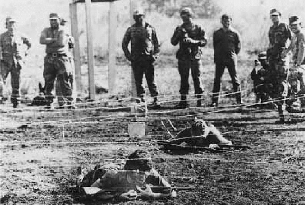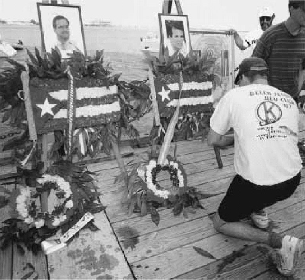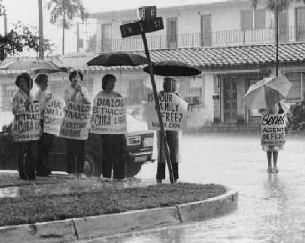Miami's Panopticon
Most societies create for themselves a series of opposing systems designed to define what is good and what is evil. This binary system contrasts what is legal with what is illegal, what is acceptable with what is unacceptable, what is criminal with what is not criminal, and so on. Societies can construe political assassinations, restriction of free expression, or brute intimidation as necessary evils in the advancement of a sacred cause. Yet not all people within that society, though they may agree with the ultimate end, may agree with the tactics used to achieve the goal. The question becomes, How do these violent tactics become acceptable in the eyes of a society at large? The answer is, It can be done only by reducing what is good and what is evil to a simple opposition between what is "normal" and what is pathological (Foucault 1973, 73).
When a society is engaged in a holy war—such as la lucha against Satan, personified as Fidel Castro—warlike activities, killings, bombings, and censorship must be employed to ensure the final victory of good. It becomes normal, regardless of how distasteful it may be, to accept the spilling of blood. In fact, it becomes a moral imperative. According to Rodolfo Frómeta, the commander of Commandos F-4 who served three years in federal prison for trying to buy U.S. armaments to be used in Castro's assassination, killing Castro would not be murder but rather "an attempt to do justice about a person who has killed thousands and thousands of persons."[14] These victims include his son, father, and brother. For Frómeta, and for the rest of his community, a new definition of justice is at work in which the actions taken to bring about this justice about become rationalized and justified. In addition, determining what is normal by mounting the social structures of power becomes a way of preserving
Because the "enemies of Cuba" (read, those who are not us) are a threat to "truth," they must be silenced at all costs. A holy war has been waged for more than forty years against the Castro regime, presented to the general public as part of the "evil empire," á la then-president Ronald Reagan. This holy war includes the bombing of the Mexican (1979) and Venezuelan (1983) consulates in Miami, the 1979 bombing of the TWA terminal at Kennedy Airport, the 1978 Avery Fisher Hall bombing at Lincoln Center, the multiple bombings of the Cuban Mission to the United Nations, the machine gun assassination of Cuban attaché Félix Garcia Rodríguez, and the attempted assassination of Cuban United Nations ambassador Raúl Roa Kouri. Other terrorist acts include, but are not limited to, the unsuccessful 1964 bazooka shelling of the United Nations during Che Guevara's speech, the 1978 bombing of the offices of the newspaper el Diario-La Prensa, the 1979 bombing of the Soviet Mission to the United Nations, and the 1980 bombing of Aeroflot ticket offices.
During the 1970s, Exilic Cuban militants formed secret organizations like Frente de Liberación Nacional (National Liberation Front), Acción Cubana (Cuban Action), Omega Siete (Omega Seven), Gobierno Cubano Secreto (Secret Cuban Government), and Jóven Cuba (Young Cuba) to participate in violent confrontations against both Resident and Exilic targets (Gonzalez-Pando 1998, 54). In 1979, after Muñiz Varela was assassinated in San Juan, Puerto Rico, by "Comando Cero" for his participation in the inter-Cuban dialogue, Comando Cero released a statement to the United Press International: "Any Cuban or Puerto Rican,

Guerrilla training camps: About eight hundred Exilic Cubans trained in 1981 at a camp near Miami for possible guerrilla operations in Nicaragua, Cuba, and/or Panama. Weapons are AR-15, civilian versions of M-16 rifles. Courtesy of the Historical Museum of Southern Florida.
The 1997 bombings of tourist locations in La Habana, which killed an Italian tourist, wounded seven, and caused extensive property damage, was masterminded by a seventy-year-old Exilic Cuban named Luis Posada Carriles, who has claimed responsibility.[15] Posada allegedly was trained by the CIA in the 1960s, was the centerpiece of the Reagan administration's efforts to supply arms to the Nicaraguan Contras, and has been linked to assassination plots in Colombia, the Dominican Republic, Guatemala, La Habana, and Honduras. During his New York Times interview, Posada alleged a financial relationship with the deceased CANF cofounder, Mas Canosa, whose organization allegedly provided more than $200,000.[16] Posada chuckled when he stated that the money would arrive with a message from Mas Canosa, "This is for the church." More recently, the FBI uncovered a plot allegedly masterminded by
That mártires de la lucha are regarded as patriots is evident in how the Exilic community venerates Orlando Bosch. The U.S. Department of Justice has linked Bosch to terrorist attacks in Miami and Latin America. Such alleged terrorism included a 1963 aerial strike at a Cuban refinery that killed three children, the shelling of a Polish freighter in the Port of Miami (for which he was convicted in 1968), and a 1976 bombing of an Air Cubana jetliner that claimed the lives of seventy-three passengers, most of whom were teenage members of Cuba's national fencing team (for which Bosch was acquitted in Venezuela in 1986). An unsupported allegation was also made during the 1978 House Select Committee on Assassinations placing Lee Harvey Oswald at Bosch's Miami home two months before Kennedy's assassination and both in Dallas around November 20 (Didion, 1987, 134–35). Yet the Miami City Commission, recognizing Bosch as a mártir de la lucha, declared March 25, 1983, to be "Dr. Orlando Bosch Day."
More recently, a grand jury indicted seven prominent Exilic Cubans accused of conspiring to assassinate Castro during the 1997 Latin American summit at the Venezuelan Island of Margarita, a clear violation of the U.S. Neutrality Act. The U.S. Coast Guard, responding to an October 27 distress call from the forty-six-foot yacht La Esperanza (the Hope), discovered five alleged assassins (between sixty and seventy years old) carrying two.50-caliber semiautomatic rifles, night-vision goggles, and satellite positioning devices. One of the men, Angel Manuel Alfonso, blurted out the plot. Among those indicted with the five on the yacht was Jose Antonio Llama (owner of the yacht), who sits on the executive board of CANF, and Francisco "Pepe" Hernandez (owner of one of the weapons), who replaced Mas Canosa as chairman of CANF. These indictments occurred during the Clinton administration, leading Juan Masimi Soler, lawyer of one of the defendants, to profess the veneration of such mártires de la lucha when he said, "If this were Ronald Reagan, or

Mártires de la lucha: A year after the event, Orlando Gutierrez kneels before pictures of the fallen Brothers to the Rescue downed in 1996 by Cuban MiG fighters. The Miami Exilic Cuban community recognizes these men as martyrs in the struggle for a free Cuba. Photograph © A. Enrique Valentin/The Miami Herald.
Although Exilic Cubans consider themselves "free," in reality Miami can be understood through the paradigm of the "panopticon" as offered by philosopher Michel Foucault. Panopticism describes a model prison in which the center is occupied by a guard tower enabling guards to gaze at the prisoners in their individual backlit cells, while the prisoners are unable to gaze back at the guard. The guard's ability to gaze confers power on the observer while setting a trap for those being observed, even when the surveillance is not constant. The mere possibility of being watched forces the prisoners as Objects to internalize the power relation. In Foucault's words:
He who is subjected to a field of visibility, and who knows it, assumes responsibility for the constraint of power; he makes them play spontaneously upon himself; he inscribes in himself the power relation in which he simultaneously plays both roles; he becomes the principle of his own subjection. By this very fact, the external power may throw off its physical weight; it tends to the non-corporal; and, the more it approaches this limit, the more constant, profound and permanent are its effects: it is perpetual victory that avoids any physical confrontation and which is always decided in advance. (1995, 202–3)
It would be naive to view power as belonging only to the elite. Power is everywhere, forming and passing through a multitude of institutions. It is most effective when it is exercised through a coercion that appears natural and neutral, a coercion based on the simple ability to observe. The panopticon, as a mechanism of exercising power, serves as a model for how oppressive power works on the streets of Miami. The bomb that is overtly targeted at one offending "heretic" is symbolically directed at all potential "sinners." For this reason the public display of punishment must be spectacular, seen by all as a triumph of "justice." The excess of violence becomes a religious ritual that purifies the whole society through the sacrificial death of the heretic who bears the sins of those who defile what has been defined as good. Public punishment, at its extreme, brings into play the dissymmetry between the heretic who has dared to go against the doctrines of la lucha and the constructed all-powerful will of the Exilic community, which displays its power by communicating what will happen to those who refuse to conform to the "truth" as established and defined by that community.
These public demonstrations are not intended to establish justice but to manifest power, and, through that power, to prevent the repetition of the heretic's peccadillo. In light of several militant groups having declared, as the common phrase has it, "war against the enemies of Cuba's freedom," past punishment serves as the instrument for preventing others from straying from the official religious doctrines of la lucha. Punishment, above all else, is always directed at all potential heretics. Hence it is never a mechanism solely of prohibition but also of production—the production of political and social subservience. All must know about the possibility of violence because all must be made to feel afraid; and all must bear witness to its infliction so as to, to a certain extent, partake in its unleashing. Only an inefficient social structure will continue to constrain through the use of brute force when the religious fervor of la lucha, normalized as truth in the minds of the community, provides a better way of obtaining conformity.
With time, the fear of punishment in the form of bombs and machine guns is no longer needed to maintain discipline within the Exilic Cuban community. These weapons have been so effectively used in the past that the guard's ubiquitous gaze has been internalized. A shift in the "technology of power" takes effect when yesterday's tortured public bodies scattered on Miami's sidewalks in the wake of a bombing become today's docile private bodies confined to their individual "cells." As Exilic Cubans committed to memory the terror of swift punishment, a system of diminishing penalties took hold. Instead of brute force, public ridicule or ostracism from the socioeconomic spaces of Miami became sufficient to ensure obedience. Although the use of brute force may still occasionally be required as a reminder of the punishment awaiting heretics, the bombthrowing patriots operating within the theater of punishment have increasingly become the bureaucratic patriots working within the sociopolitical hierarchy.
La lucha thus includes a comprehensive system of domination. Exilic Cuban radio stations and numerous periodiquitos (tabloids) of Miami become the unblinking eye of la lucha, serving as the guard tower.[21] The gaze of the radio stations and periodiquitos produce conformity to the religion of el exilio. These stations are not the terminal points of power. Rather, they serve as the official pulpit whose sermons spread news, disseminate rumors, denounce heretics, and constantly call for the punishment of in(Fidel)s. The airwaves and printed pages of Miami normalize the "sinner's" punishment, not as vengeance in the hands of terrorists but as a result of divine retribution. And when the instruments of God's wrath are prosecuted by the U.S. government, these instruments become martyrs of the faith. The guard in the tower, the power that demands obedience, is disguised as the basic democratic right to a free press.
Because power cannot be possessed, it can only be exercised by those privileged enough to position themselves within the dominant culture. But if misused, power can be lost and used against those who previously benefited from it. Bernardo Benes, considered one of the leading Exilic Cubans in the late 1970s, lost his position of power and privilege when he met with Castro to explore the possibilities of reconciliation. Benes's trip to Cuba resulted from Castro's appeal (stimulated by secret normalization talks with the Ford and Carter administrations) to engage in a dialogue about possible reconciliation with Exilic Cubans. An olive branch was offered when Castro publicly stated he might have "misjudged" the "Cuban community abroad."[22] El diálogo divided the Exilic community when what became known as el comité de los 75 (the committee of the
Those who participated in el diálogo were labeled traitors, communists, vendepatrias (sellouts), tontos inutiles (useless idiots), and mariposas (butterflies, a euphemism for homosexuals) by Miami's Exilic Cuban radio stations and periodiquitos. One Exilic Cuban periodiquito (La Crónica, translated as the "chronicle" or the "story") published the names, addresses, and telephone numbers of those supporting el diálogo so that "real" Cubans could personally express their anger.[23] On several occasions, as late as 1986, some Exilic Cuban radio stations were fined by the Federal Communications Commission for inciting riots. Benes described the panopticon function of these radio stations and tabloids when he stated, "A million Cubans are blackmailed, totally controlled, by three radio stations. I feel sorry for the Cuban community in Miami. Because they have imposed on themselves, by way of the Right, the same condition that Castro has imposed on Cuba. Total intolerance. And ours is worse. Because it is entirely voluntary" (Didion 1987, 113). To live in el exilio of Miami is to consent to one's own subjugation while hoping that la lucha will radically provide salvation from one's estranged existence.
The events surrounding the scheduled performance of Dolores Prida's one-act play, Coser y cantar (Sew and sing), during the First Annual Festival of Hispanic Theater in 1986 also illustrates how Miami's panopticon functions. Coser y cantar explores the struggle of an Exilic Cuban woman caught between two cultures. A bilingual monologue develops between the Spanish-speaking "Ella" who represents her cultural heritage, and the English-speaking "She" who represents her Angloization. As both sides of her personality bitterly bicker for mastery, Ella/She concludes that both selves are crucial for survival. The play was canceled because of numerous radio denunciations and bomb threats. Why? Dolores Prida was suspected of communist leanings. Her experience in Miami led her to claim that the only city besides Miami where she has been afraid to express herself, "where people look over their shoulder to see if they can say what they were going to say," is La Habana. And on October 19, 1998, someone lit fire to Club Amnesia in Miami Beach in response to a scheduled

Protesting Bernardo Benes: A group of Exilic Cuban women protests across the street from the Continental National Bank (where Bernardo Benes was a vice president), in spite of the pouring rain. Posters read "Dialogue is treason to our martyrs," "Dialogue is treason to a free Cuba," and "Benes is an agent of Fidel." Courtesy of the Historical Museum of Southern Florida.
In Miami former comrades can easily become deadly enemies. Forty years after the CIA-backed Playa Girón invasion, a conference was held in Cuba to discuss the events of 1961. Nine members of the Brigade 2506, who fought to dethrone Castro, now accepted his invitation to the conference. They were exploring a new strategy for dealing with Castro's government, one of open dialogue. Yet, in spite of their membership in the Brigade, seen as a badge of honor among the faithful, they were now seen as enemies of la lucha, backsliding sinners who had lost their way, traitors sin vergüenza (with no shame). Hence they were officially kicked out of the Brigade 2506, becoming personae non gratae. Mario Cabello, who was among those ousted, had to be escorted out of the building for his own safety. "It's ironic that forty years ago when I was captured by
These wounds are not inflicted by a centralized Exilic Cuban elite. Rather, the power to inflict wounds on the docile body resides in a multitude of networks (such as radio stations and periodiquitos) woven into the political economy of the elite. Therefore, replacing the elite would not suffice in eliminating these networks, which are ingrained in Miami life. Benes's experience proves the autonomy of a disciplinary structure designed to punish dissenters of la lucha, even those among the elite. The tragedy of Miami's panopticon is that those who exercise power are not necessarily aware of their complicity in the power structures of the Exilic community or of their own self-subjugation to those structures owing to their belief in the holy cause of la lucha (De La Torre 2001, 196–200).